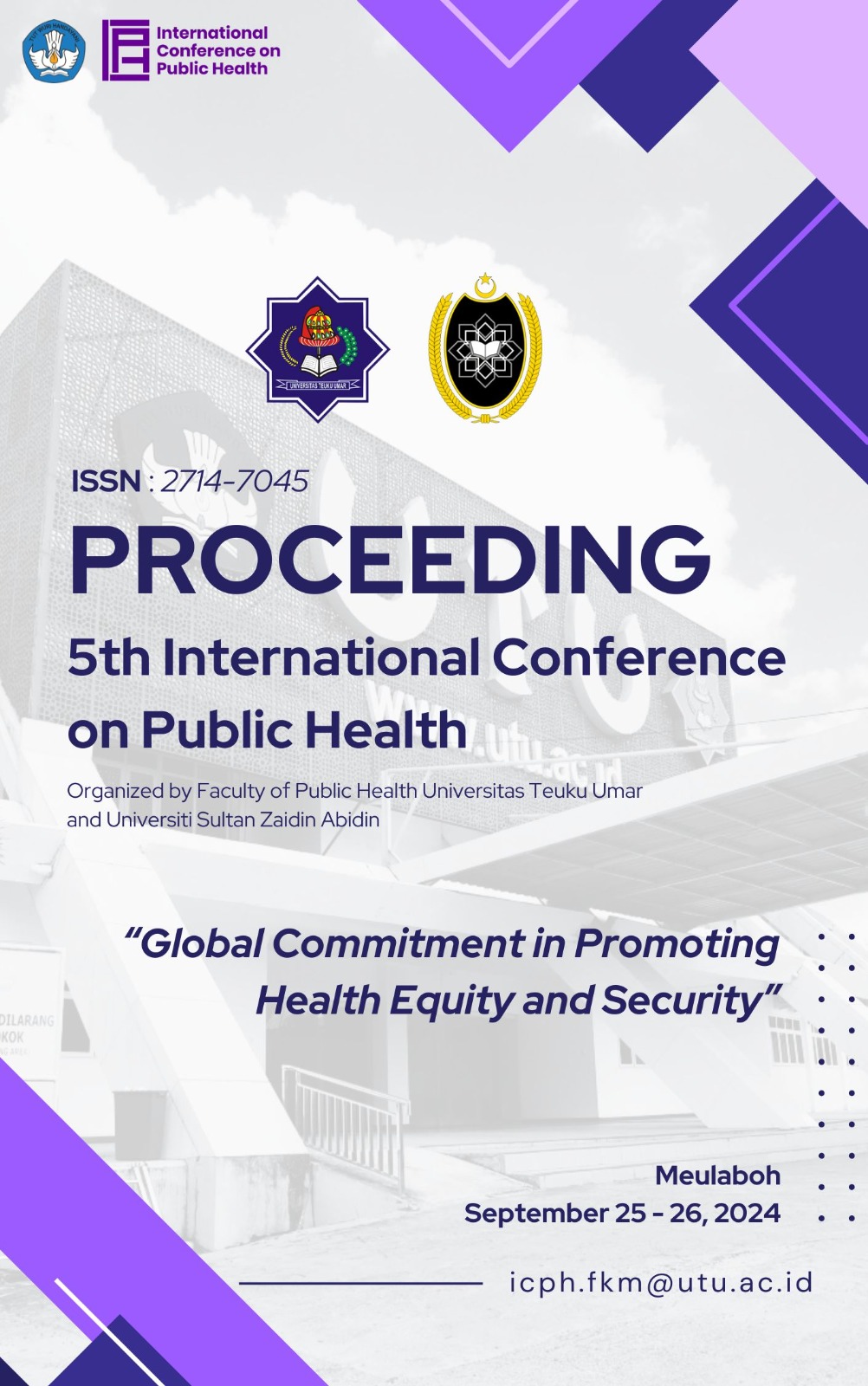Study On Hexsavalen Chromium Content (Cr6+) In Raw Water Source Of Krueng Meurebo River, West Aceh
Keywords:
Cr6+, Hexavalent Chromium, River, Water, West AcehAbstract
Illegal industrial and mining activities in the upstream coastal area of West Aceh are at risk as a source of heavy metal pollution for raw water sources of local communities. One of them is chromium VI (Cr6+) heavy metal which is harmful because it cannot decompose in the body and become a poison that causes health effects on humans as well as aquatic organisms. The Krueng Meureubo River, as the main source of raw water that meets the clean water needs of the local community, is now threatened by this potential contamination. Objective: This study aims to analyze Cr6+ exposure in raw water source of the Krueng Meurebo River, West Aceh. Water sampling was carried out at 3 points along the Krueng Meurebo River, namely the waters of the Tuha Mosque, Ranto Panyang Barat and Runding. Each sample was analyzed using a tablet reagent, followed by further examination using the ZE-200 photometer to determine the content of heavy metal Cr6+ at each sampling points. The results of the analysis of Cr6+ heavy metal exposure in the waters of the Tuha Mosque were 0.10 mg/l, while the results in Ranto Panyang and Runding were 0.08 mg/l. This result is above the maximum limit of Cr6+ content allowed in water as many as 0.01 mg/l. The Krueng Meureubo River stream shows significant levels of exposure to heavy metals Cr6+, posing a serious threat to the health of communities who rely on the river's raw water source. With these conditions, immediate action is needed in the form of an Environmental Health Risk Analysis (ARKL) to further assess the impact of Cr6+ exposure on human health. Measures to prevent and handle industrial waste need to be optimized immediately to protect the environment and public health in the West Aceh region
References
Agency for Toxic Substances and Disease Registry (ATSDR). (2012). Toxicological Profile for Chromium. U.S. Department of Health and Human Services, Public Health Service.
Costa, M., & Klein, C. B. (2006). Toxicity and Carcinogenicity of Chromium Compounds in Humans. Critical Reviews in Toxicology, 36(2), 155–163.
Dewan Sumber Daya Air Nasional. (2019). Rekomendasi Isu Strategis Ketahanan Air. https://www.dsdan.go.id/mdocs-posts/2019-rekomendasi-isu-strategis-ketahanan-air
Edwarsyah, & Iqbal, M. (2017). Kuantitas Kandungan Logam Berat dan Minyak Solar di Estuaria Krueng Cangkoi, Meulaboh, Kabupaten Aceh Barat. Acta Aquatica: Aquatic Sciences Journal, 4(2), 83–87. https://doi.org/10.29103/AA.V4I2.307
Georgaki, M. N., Charalambous, M., Kazakis, N., Talias, M. A., Georgakis, C., Papamitsou, T., & Mytiglaki, C. (2023). Chromium in Water and Carcinogenic Human Health Risk. Environments, 10(2), 33. https://doi.org/10.3390/ENVIRONMENTS10020033
Goyer, R. A., & Clarkson, T. W. (2001). Toxic Effects of Metals. In Klaassen, C. D. (Ed.), Casarett and Doull's Toxicology: The Basic Science of Poisons (6th ed.). McGraw-Hill.
Jumhasla Putra, A. Z., Masimin, M., & Fatimah, E. (2018). Kajian Kerugian Risiko Banjir Pada Sungai Krueng Meureubo. Jurnal Arsip Rekayasa Sipil Dan Perencanaan, 1(2), 172–182. https://doi.org/10.24815/JARSP.V1I2.10966
Kazakis, N., Kantiranis, N., Kalaitzidou, K., Kaprara, M., Mitrakas, M., Frei, R., Vargemezis, G., Tsourlos, P., Zouboulis, A., & Filippidis, A. (2017). Origin of hexavalent chromium in groundwater: The example of Sarigkiol Basin, Northern Greece. Science of The Total Environment, 593–594, 552–566. https://doi.org/10.1016/J.SCITOTENV.2017.03.128
Kementerian Lingkungan Hidup dan Kehutanan. (2022). Status Lingkungan Hidup Indonesia 2022.
Mishra, S., & Bharagava, R. N. (2016). Toxic and genotoxic effects of hexavalent chromium in environment and its bioremediation strategies. Journal of Environmental Science and Health, Part C, 34(1), 1–32. https://doi.org/10.1080/10590501.2015.1096883
Moraetis, D., Nikolaidis, N. P., Karatzas, G. P., Dokou, Z., Kalogerakis, N., Winkel, L. H. E., & Palaiogianni-Bellou, A. (2012). Origin and mobility of hexavalent chromium in North-Eastern Attica, Greece. Applied Geochemistry, 27(6), 1170–1178. https://doi.org/10.1016/J.APGEOCHEM.2012.03.005
Munandar, & Alamsyah, A. (2016). Kajian Kandungan Logam Berat Merkuri (Hg) Pada Kerang Air Tawar (Anodonta sp) Di Kawasan Hilir Sub DAS Krueng Meureubo, Aceh Barat. Jurnal Perikanan Tropis, 3(1). https://doi.org/10.35308/JPT.V3I1.32
Nair, D. S., & Kurian, M. (2018). Chromium-zinc ferrite nanocomposites for the catalytic abatement of toxic environmental pollutants under ambient conditions. Journal of Hazardous Materials, 344, 925–941. https://doi.org/10.1016/J.JHAZMAT.2017.11.045
Peraturan Menteri Lingkungan Hidup Dan Kehutanan Republik Indonesia Nomor 5 Tahun 2021, Menteri Lingkungan Hidup dan Kehutanan Republik Indonesia. (2021). https://jdih.menlhk.go.id/new/uploads/files/2021pmlhk027_menlhk_12312021144624.pdf
Qanun Kab. Aceh Barat No. 4 Tahun 2021 Perusahaan Perusahaan Umum Daerah Air Minum Tirta Meulaboh. Retrieved March 29, 2024, from https://peraturan.bpk.go.id/Details/239942/qanun-kab-aceh-barat-no-4-tahun-2021
Rai, P. K., Lee, S. S., Zhang, M., Tsang, Y. F., & Kim, K. H. (2019). Heavy Metals in Food Crops: Health Risks, Fate, Mechanisms, and Management. Environment International, 125, 365–385.
Saha, R., Nandi, R., & Saha, B. (2011). Sources and toxicity of hexavalent chromium. Journal of Coordination Chemistry, 64(10), 1782–1806. https://doi.org/10.1080/00958972.2011.583646
Tchobanoglous, G., Burton, F. L., & Stensel, H. D. (2003). Wastewater Engineering: Treatment and Reuse (4th ed.). McGraw-Hill.
Tchounwou, P. B., Yedjou, C. G., Patlolla, A. K., & Sutton, D. J. (2012). Heavy Metals Toxicity and the Environment. EXS, 101, 133. https://doi.org/10.1007/978-3-7643-8340-4_6
Warni, D., Karina, S., & Nurfadillah, N. (2017). Analisis Logam Pb, Mn, Cu dan Cd Pada Sedimen di Pelabuhan Jetty Meulaboh, Aceh Barat. Jurnal Ilmiah Mahasiswa Kelautan Perikanan Unsyiah, 2(2), 246–253. https://jim.usk.ac.id/fkp/article/view/4862
WHO. (2017). Total Dissolved Solids in Drinking-water. Guidelines for Drinking-water Quality, 4th Edition. World Health Organization.
Zhang, R., Xiang, Y., Ran, Q., Deng, X., Xiao, Y., Xiang, L., & Li, Z. (2014). Involvement of Calcium, Reactive Oxygen Species, and ATP in Hexavalent Chromium-Induced Damage in Red Blood Cells. Cellular Physiology and Biochemistry, 34(5), 1780–1791. https://doi.org/10.1159/000366378





